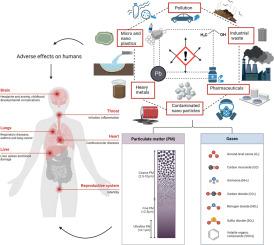环境清理的前沿:修复土壤和水中新污染物的最新进展
IF 5.4
Q2 ENGINEERING, ENVIRONMENTAL
引用次数: 0
摘要
环境修复领域的最新进展大大改善了土壤和水污染的处理,但新出现污染物的复杂性和分散性仍然是主要挑战。本综述重点介绍了最有前景的修复技术和策略,强调了它们在保护生态系统和人类健康方面的潜力。在土壤修复方面,植物修复利用植物吸收和固定污染物,而生物修复则利用微生物以可持续的方式降解有机污染物。纳米技术利用纳米颗粒作为高效吸附剂或催化剂,提供了创新的解决方案。在水质修复方面,光催化和臭氧等高级氧化工艺(AOPs)可有效降解难降解污染物,提高水质。生物炭和其他吸附剂为去除污染物提供了可行的选择,反渗透等膜技术为各种应用提供了选择性净化。综述强调了多学科合作在推进修复技术方面的重要性。整合人工智能和机器学习可以通过分析复杂数据和预测污染物行为进一步优化这些过程。随着环境挑战的不断变化,持续的创新和研究对于应对新出现的污染物至关重要。本综述呼吁科学界采取行动,采用跨学科方法和尖端技术,为子孙后代保护环境。本文章由计算机程序翻译,如有差异,请以英文原文为准。

Frontiers in environmental cleanup: Recent advances in remediation of emerging pollutants from soil and water
Recent advancements in environmental remediation have significantly improved the treatment of soil and water pollution, yet the complexity and dispersion of emerging pollutants remain major challenges. This review highlights the most promising technologies and strategies in remediation emphasizing their potential to protect ecosystems and human health. In soil remediation, phytoremediation utilizes plants to absorb and immobilize pollutants while bioremediation employs microorganisms to degrade organic contaminants in a sustainable manner. Nanotechnology offers innovative solutions through the use of nanoparticles as efficient sorbents or catalysts. For water remediation, advanced oxidation processes (AOPs) such as photocatalysis and ozonation effectively degrade recalcitrant pollutants enhancing water quality. Biochar and other sorbents present viable options for pollutant removal and membrane technologies like reverse osmosis provide selective purification for diverse applications. The review underscores the importance of multidisciplinary collaboration in advancing remediation technologies. Integrating artificial intelligence and machine learning can further optimize these processes by analyzing complex data and predicting pollutant behavior. As environmental challenges evolve, continuous innovation and research are essential to combat emerging pollutants. This review serves as a call to action for the scientific community to embrace interdisciplinary approaches and cutting-edge technologies to safeguard the environment for future generations.
求助全文
通过发布文献求助,成功后即可免费获取论文全文。
去求助
来源期刊

Journal of hazardous materials advances
Environmental Engineering
CiteScore
4.80
自引率
0.00%
发文量
0
审稿时长
50 days
 求助内容:
求助内容: 应助结果提醒方式:
应助结果提醒方式:


